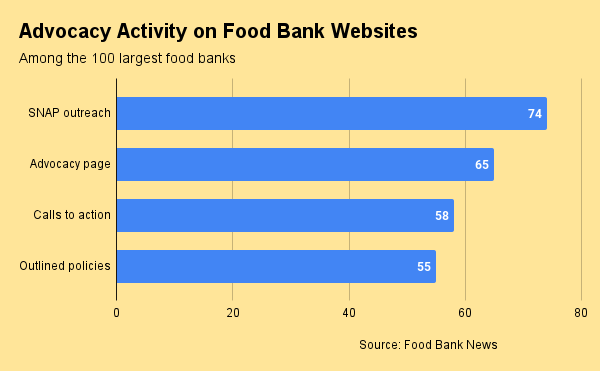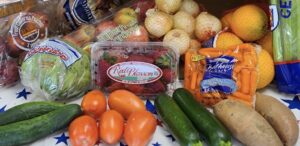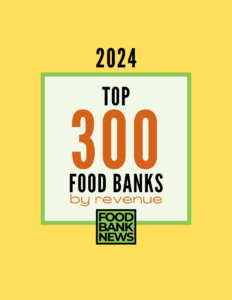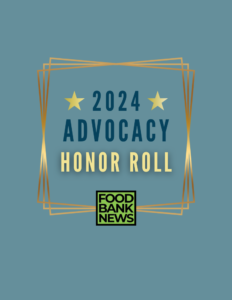Our scan of the top 100 food banks (by revenue) uncovered a number of features food banks are adding to their websites to advance their advocacy efforts, including animated videos, advocacy-action point trackers, and surveys of the general public.
These findings are part of our annual look at how food banks promote advocacy through their digital presence. While advocacy mostly happens “in real life” through conversations, meetings and lobbying, there is much that food banks can do through their websites to raise awareness and advocacy around hunger relief.
This year, we found that 44 food banks out of the top 100 (by revenue) are active in all four areas identified as being important to website advocacy, earning them placement on our “High Honor Roll.” These four areas include having SNAP outreach, having an advocacy page, having calls to action, and outlining policy priorities.
Another 17 food banks were found to be active in three of the four areas, granting them the distinction of “Honor Roll.” (Our findings cover only the website advocacy activities of the 100 largest food banks by revenue, as identified in our 2023 report of the Top 300 Food Banks.)
For a detailed look at all the food banks on our High Honor Roll and Honor Roll, see our special report, “2024 Advocacy Honor Roll.”
One of the most basic ways to advocate is simply to have a page devoted to advocacy on the website. Of the top 100 food banks, we found 65 that do so, with some making more of a splash than others. Houston Food Bank has taken its website advocacy effort to the next level with a multi-page resource that aims to get people engaged and enthused. Its Advocacy Action Center offers high-level explainers on everything from why the Farm Bill is important to how economic instability drives food insecurity.
A detailed video breaks down the ins and outs of the local government, easing the way to greater civic engagement. And the Tough Choices Challenge illustrates how food insecurity can sneak up on hard-working families. In addition to its Advocacy Action Center, the food bank, which recently hired its first Civic Engagement Specialist, has a page devoted to voting, encouraging people to “stand up for what they believe in” and to “have a voting plan.”
Greater Boston Food Bank took the opportunity on its advocacy pages to highlight the dozens of advocacy actions the food bank itself has taken, such as submitting written testimonies and endorsing bills. It also touts its successes, helping to illustrate the impact that a coordinated advocacy effort can have.
A simple approach also works. Second Harvest Heartland does a great service on its Advocacy 101 page by answering basic questions like ‘What is Advocacy?’ and ‘How Does Advocacy Work?’ In its FAQ, it eases any hesitation about advocacy being “too political” by promoting hunger relief as a non-partisan issue important to both parties.
On food-bank advocacy pages, we also look for calls to action, which 58 of the top 100 food banks offer. These could include encouraging people to sign up for a newsletter, watch a webinar, or reach out to a legislator. On its website, East Texas Food Bank offers tips on how to have effective meetings and phone calls with elected officials. Philabundance’s 55-page Advocacy Toolkit offers a wide range of useful information, including a chart of the advocacy activities people can take, whether they have 15 seconds or one hour of time.
Greater Chicago Food Depository’s Take Action Now page is a sophisticated call-to-action approach that assigns points to various advocacy actions, tracks how many actions have so far been taken by the public, and how many more are needed to reach the next goal level. The page even encourages people to log their interactions and relationships with legislators in case one might be a neighbor, for example.
We found that food banks are least likely to outline their specific policy priorities on their advocacy pages, with only 55 of them doing so. Breaking policies down into the federal, state and even local level is useful. Foodbank for the Heartland, whose service area straddles two states, does this in an intuitive way using clickable tabs across the page.
Increasingly, food banks are highlighting policies that go beyond hunger-related legislation. Food Lifeline, for example, includes climate change and tax cuts for the wealthy in its agenda, in addition to policies related to hunger relief. Alameda County Community Food Bank invites the public to help set the policy agenda by filling out a short survey to describe the issues that are important to them.
Food banks are most likely to promote SNAP on their sites, including by making it easy for people to find out about it and sign up. Seventy-four of the top 100 food banks engage in this practice. While SNAP sign-ups may not technically constitute advocacy, we believe that getting more people using SNAP counts as a great way to sustain and grow the program.
Many food banks post helpful guidelines like income requirements and links to quick-screening forms in their SNAP outreach. Feeding America Riverside and San Bernardino Counties, for example, lets users see if they qualify for SNAP by clicking through to a form from mRelief. FARSB also includes the contact information and photos of its SNAP assistants right on the site, and has FAQs in both English and Spanish.
Feeding San Diego’s SNAP outreach page has many of these same qualities, and also offers resources designed to quell anxiety about applying for SNAP, like what to expect during SNAP eligibility interviews, and a SNAP myth buster. A Q&A about the SUN Bucks summer lunch program is well-placed among the SNAP outreach.
Some food banks are using digital assets to convey information about SNAP, like Second Harvest Food Bank of Central Florida’s detailed instructional video. Redwood Empire Food Bank has a more conceptual take, using only sound effects in this quirky, fun video to present the SNAP application process as easy and gratifying.
The ability to use SNAP for online shopping is relatively new, but Northern Illinois Food Bank is on top of it, with resources about how people can use their SNAP card to make food purchases online through Amazon and other providers. – Chris Costanzo, with research provided by Kathy Ou.
Like what you’re reading?
Support Food Bank News








